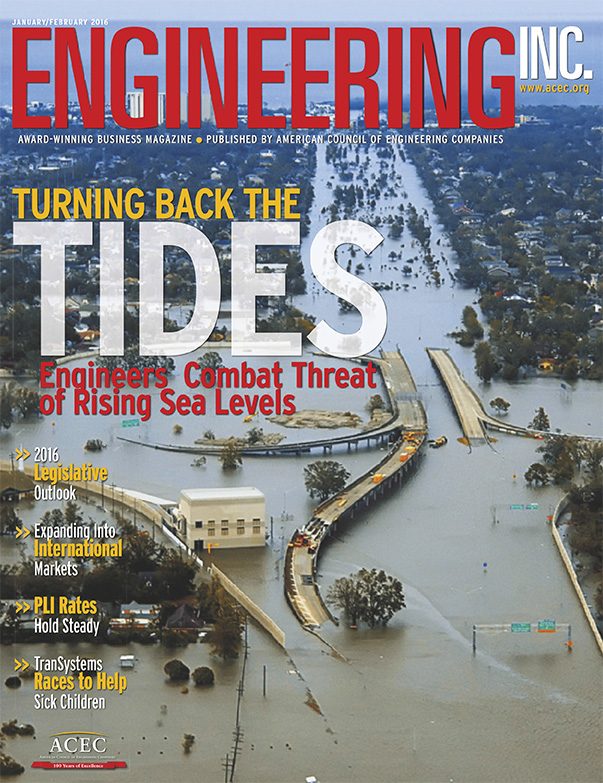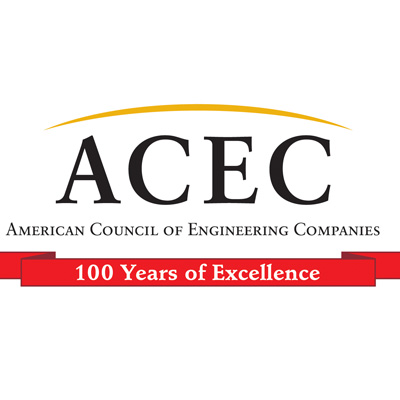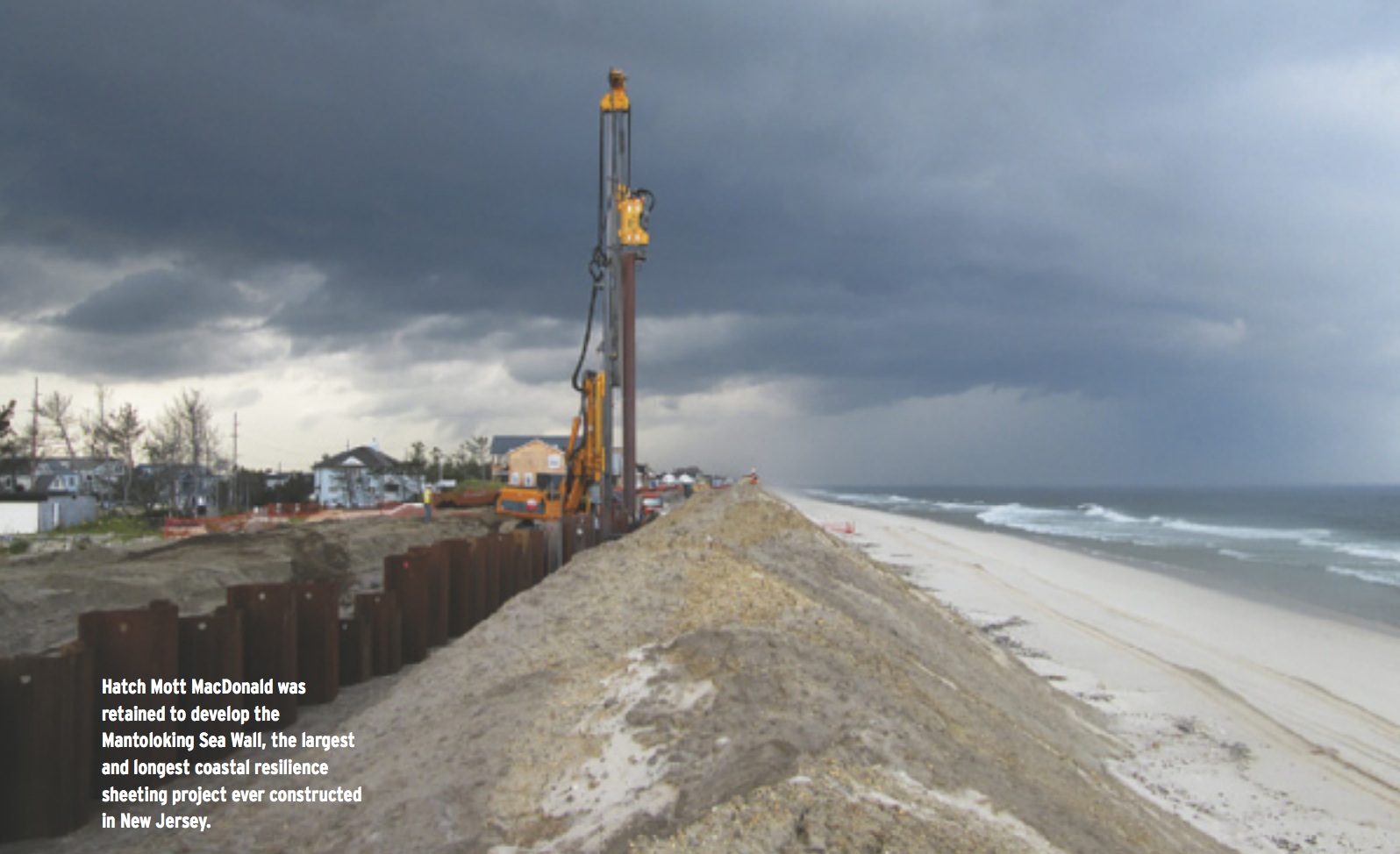AMERICAN COUNCIL OF ENGINEERING COMPANIES
Nation looks to engineering to address the threat of rising sea levels
By Samuel Greengard
 It’s difficult to open a newspaper or read social media without seeing a mention of how something is affecting the environment. Yet, beyond all the discussions, arguments and political viewpoints concerning the role humans play in this, one simple fact stands out: sea levels are on the rise and coastal areas are increasingly affected by tidal flooding, and engineers are being called upon to do something about it.
It’s difficult to open a newspaper or read social media without seeing a mention of how something is affecting the environment. Yet, beyond all the discussions, arguments and political viewpoints concerning the role humans play in this, one simple fact stands out: sea levels are on the rise and coastal areas are increasingly affected by tidal flooding, and engineers are being called upon to do something about it.
The entire east coast of the United States is particularly vulnerable as rising sea levels could impact—and perhaps even displace—between 20 to 30 million people spanning 20 cities with populations over 100,000, according to a report in the journal Proceedings of the National Academy of Sciences. Those cities include Boston, Miami, Virginia Beach, Sacramento, New Orleans, Jacksonville and New York.
Research shows that sea levels across the Northeast Coast rose nearly four inches between 2009 and 2010. Along the coast from Boston to North Carolina, sea levels are rising three to four times faster than the global average.
The evidence is irrefutable. “We have a very precise global view of sea level change based on nearly 23 years of satellite altimeter measurements,” says R. Steven Nerem, a professor of aerospace engineering at the University of Colorado.
He pointed to a 2014 study conducted by the National Oceanic and Atmospheric Administration (NOAA), which found that at 45 tide gauges around the Atlantic and Gulf of Mexico coasts, the frequency of flooding had increased at 41 locations. Moreover, the rate of increase was accelerating at 28 of the locations.
“The loss of ice from Greenland, Antarctica and mountain glaciers contributes to about one-third of the increase. We also are witnessing a thermal expansion of the oceans, which further contributes to sea level rise,” Nerem says.
Taking Action
“The undisputed fact is that sea levels are not going down,” says Michael McMahon , senior hydro-meteorologist at HDR Engineering. “It means that for many U.S. east coast cities there are only two options…move the city further from the coast, or build enormous sea walls.”
HDR is working with New York City on its plan to make city buildings and infrastructure more resilient against the effects of rising tides and storm surges. Flooding after Superstorm Sandy left 43 dead and more than $19 billion in damage. New York City’s $20-billion resiliency plan calls for a complex system of permanent levees, storm barriers and other defenses.
James Schlaman, director of water resources at Black & Veatch says the slow and incremental nature of the ice melt in the Polar Regions means that a rise in sea levels may not be entirely apparent in some areas until a major storm surge occurs. At that point, severe flooding could wreak havoc on infrastructure, including freshwater systems.
“The bottom line is that there are a lot of different potential scenarios, but all of them lead to varying levels of problems.” Schlaman said. “We must recognize and address the reality that rising sea levels will touch a lot of people’s lives and have a major impact on infrastructure.”
Schlaman says Black & Veatch is working with officials in California, Louisiana and elsewhere to develop plans and projects, including dual-feed pump stations, seawalls and emergency generation systems.
Hatch Mott MacDonald CEO Nick DeNichilo notes that coastal flooding can set off a chain reaction of disastrous events such as power failures; flooded tunnels, rail lines and subways; and an array of other problems, including an inability to obtain fuel or buy food during a major storm like Sandy or Katrina.
To combat rising sea levels, he says, the emphasis must be on adaption and resilience. “There is a need for coastal communities to focus on greater resilience and better protections in order to ensure a more sustainable future. This means addressing wide-ranging issues, including erosion control and stabilizing shorelines, building natural barriers, protecting structures from flooding, preventing the leaching of salt water into fresh groundwater, guarding freshwater supplies, and aiding utilities that can be impacted by flooded coastlines.” Hatch Mott MacDonald is involved in several projects aimed at mitigating the effects of sea level rise. Among them: designing and constructing a new sea wall along three-and-ahalf miles of oceanfront in Mantoloking, N.J. It’s the largest and longest coastal resilience sheeting project ever constructed in New Jersey.
The project, which will replenish the oceanfront with 200-foot-wide beaches and dunes with a crest elevation of 22 feet, will protect about 8,000 homes.
The company is also working with New York City to assess and possibly reinforce the Triborough Bridge and tunnels in the city.
McMahon noted how storm water discharge becomes a major issue as sea levels rise. “During a heavy rain, all the storm water is supposed to be dumped into the ocean, but when you have rising tides, getting storm water into the ocean becomes problematic,” he says.
Addressing this unfolding problem is nothing short of daunting. At the heart of the issue is the historic federal struggle to adequately fund existing infrastructure improvements, let alone develop new infrastructure designed to protect highrisk coastal areas as sea levels rise.
Download full article (PDF): Turning Back the Tides
 About the American Council of Engineering Companies
About the American Council of Engineering Companies
www.acec.org
The American Council of Engineering Companies (ACEC) is the voice of America’s engineering industry. Council members – numbering more than 5,000 firms representing more than 500,000 employees throughout the country – are engaged in a wide range of engineering works that propel the nation’s economy, and enhance and safeguard America’s quality of life. These works allow Americans to drink clean water, enjoy a healthy life, take advantage of new technologies, and travel safely and efficiently. The Council’s mission is to contribute to America’s prosperity and welfare by advancing the business interests of member firms.
Tags: ACEC, American Council of Engineering Companies, Engineering, Engineering Inc., Levees, Resilience, Samuel Greengard, Tides







 RSS Feed
RSS Feed